Our day in Florence began with a drive through the Tuscan countryside. That sounds so romantic! An hour-long ride on a bus from the port at Livorno to Florence wasn’t especially romantic, but the countryside was certainly beautiful.
Our first stop was at the Accademia Gallery in Florence where we saw the sculpture titled The Abduction of the Sabine Women. This sculpture portrays an incident in the legendary history of Rome. When Rome was a new city, Romulus—its leader—feared that there were not enough women to keep Rome populated and powerful. Residents of the surrounding area were called Sabines. When the Roman men tried to marry the Sabine women, the Sabine men feared losing their power to the Romans and made it illegal for their women to marry the Romans.
Romulus decided to trick the Sabines and scheduled a day of games and festivities. He invited the Sabines to the festival, and they came because they wanted to see the new city. At a signal from Romulus, the Roman men captured the Sabine women and fought off the Sabine men. Romulus’ wife worked to bring an end to the wars between the Romans and the Sabines and, later, Romulus basically decreed the women should accept the way things turned out and marry the Roman men.
This sculpture of that legendary event was created by Giambologna, the official sculptor of the Medici family. Our guide pointed out how different the sculpture looks from each side, and she was right.
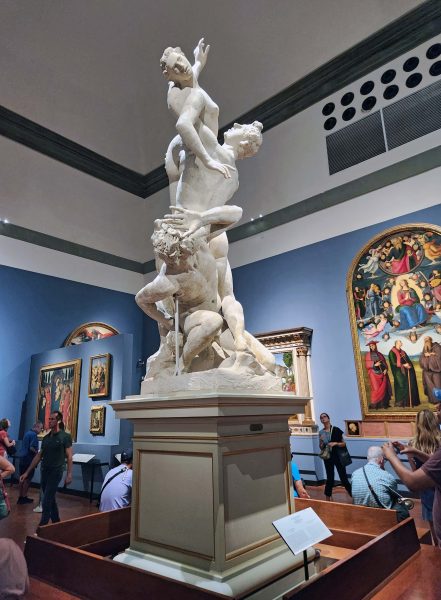


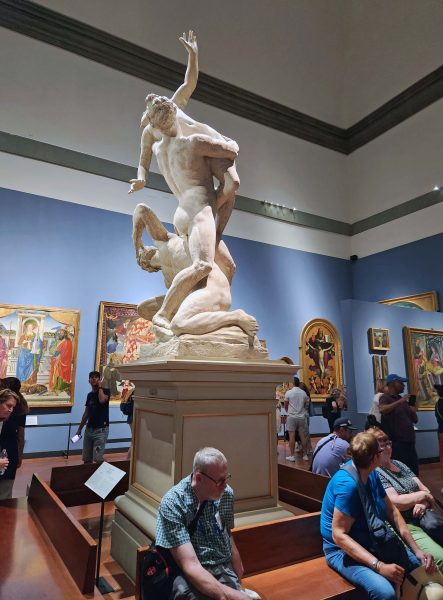
We walked through several more rooms at the Accademia before we came to the prize exhibit: Michelangelo’s David. Before we entered that room, our guide teased us by saying, “Prepare for a WOW.” She was right. WOW!
David is 17 feet tall, weighs more than 12,000 pounds, and is sculpted from a single piece of marble. Michelangelo portrayed David as a very strong man, ready to go into battle and to beat Goliath. His slingshot is over his shoulder, and he holds a rock in his right hand. The veins on his hands and arms are swollen, indicating that he’s flexing them. There’s a hollow at the base of his throat because he’s taking a deep breath. (Take a deep breath and watch the base of your throat in a mirror. You’ll see that hollow appear.) David is standing in a comfortable position with his weight on his right leg and with his left leg flexed, ready for the right moment.
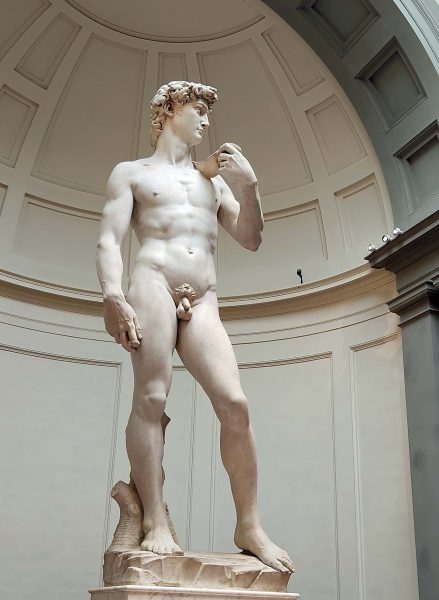
When I saw the Pietà in St. Peter’s Basilica in Rome, my heart broke for Mary because the sculpture evoked such deep pain. It sounds weird, but I could actually feel power emanating from David. How can a sculptor capture such a range of emotions from pieces of rocks??!!
Michelangelo never used models for his sculpture; he studied cadavers and sculpted from that knowledge. Master sculptors begin with clay, then they move up to plaster, and when they are very experienced, they work with marble, which is very expensive. Michelangelo went directly to marble. He sculped the Pietà when he was 23 and he was already the most famous and highest-paid sculptor when, at the age of 26, he created the David. He made David’s head oversized because the sculpture was intended to be placed in a high alcove above the main entrance to the cathedral where a normal-size head would look too small. (Un)fortunately, the sculpture was considered too risqué for the cathedral and was placed in a museum instead.
Before leaving the gallery, our guide showed us a picture of what happened to David during the COVID lockdown.
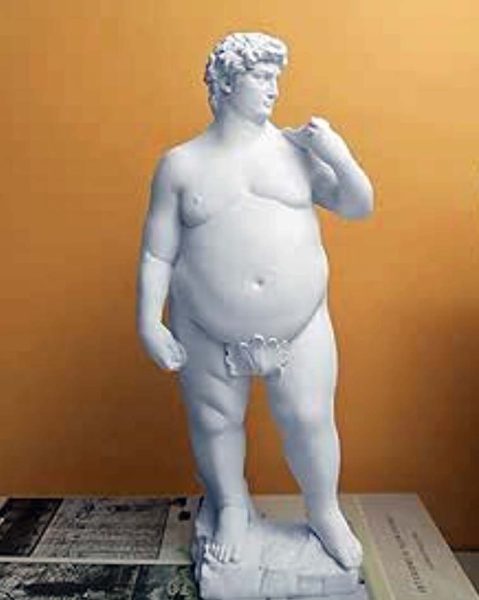
Our next stop was the Old Palace—the Palazzo Vecchio—which has been the government headquarters and the symbol of civil power in Florence since the 7th century and is the most characteristic building in the Piazza della Signoria (Signoria Square). It is still the political focus of the city.
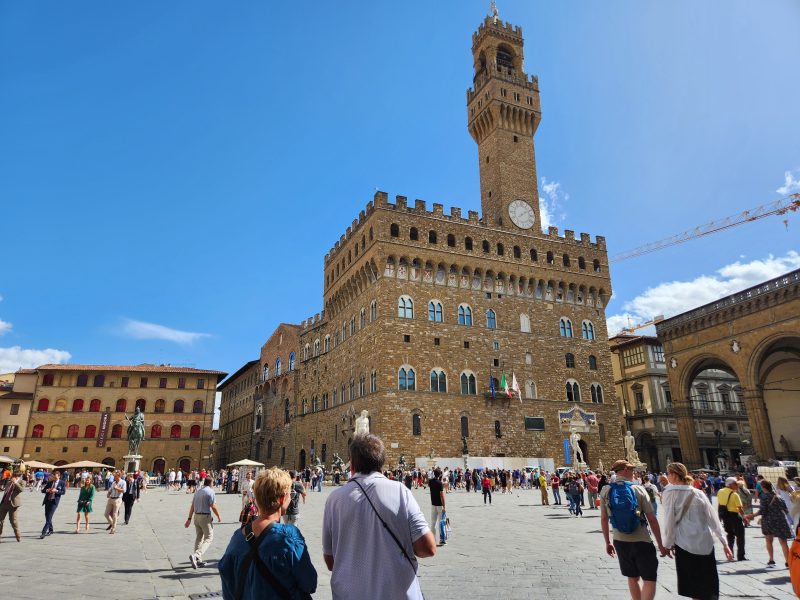
Cosimo I de Medici named himself the Grand Duke of Tuscany, giving Tuscany a total of one Grand Duke. Then he bought the Old Palace and ordered a restructuring and decoration of the building to make it his residence. According to our guide, Cosimo I’s wife thought the Old Palace was too small for their 11 children plus the governmental entities that shared the building, so Cosimo I bought the Pitti Palace across the Arno River for her. It was difficult to guard the self-proclaimed Grand Duke while he walked from building to building. To solve that problem, Cosimo I ordered the construction of the Vasari Corridor as a “secret passage” to connect the Pitti Palace on the north side of the Arno with the government administration offices in the Uffizi (office) Building on the south side of the river. This allowed him to walk from one place to the other without being seen by the public. The Uffizi Building is now the Uffizi Gallery and the Vasari Corridor, pictured below, is now called the Ponte Vecchio (Old Bridge).
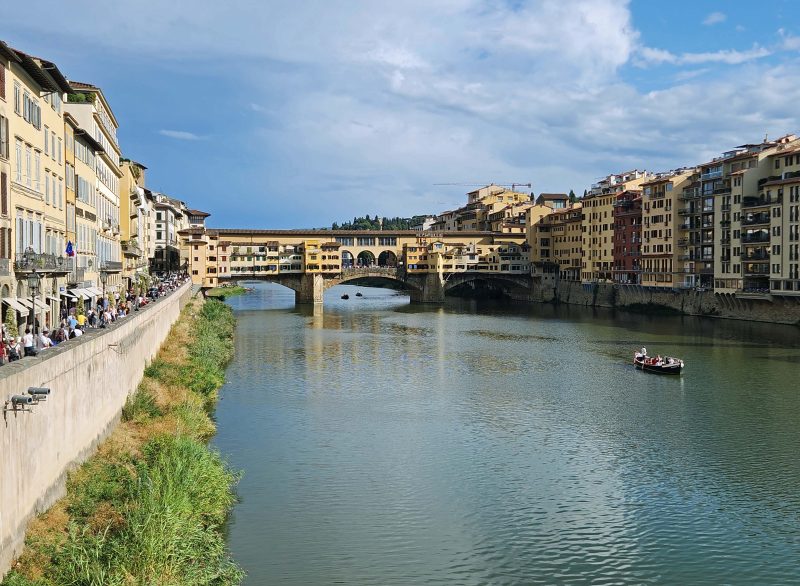
On either side of the main entrance to the Palazzo Vecchio is a pair of statues. A replica of Michelangelo’s David is on the left, and a statue of Hercules and Cacus stands on the right. The statues were commissioned by two different rulers of Florence and make a statement about the different political agendas Florence has experienced under each of its rulers. If you look at the picture of the Old Palace above, you can see this doorway with these statues at the front right corner of the building.
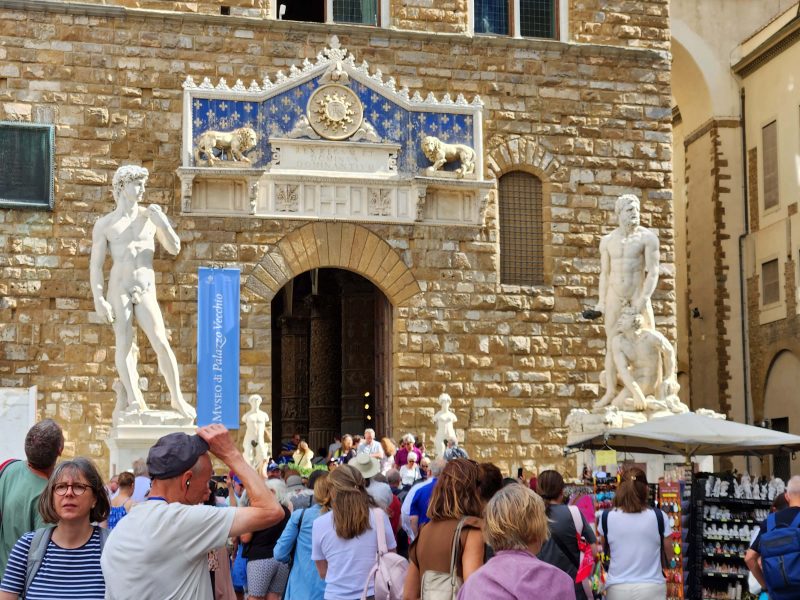
From the Palazzo Vecchio, we walked through the Piazza del Santa Croce and saw the Santa Croce Church.

Near the church is a statue of Dante Alighieri, considered to be one of the Western world’s greatest poets. He is most famous for his epic poem The Divine Comedy. You can see the statue of Dante on the left side of the church in the photo above, and a closer view of it below.

Before leaving the site of Dante’s statue, our guide told us to prepare ourselves for another WOW! and walked us across the square to the Basilica de Santa Maria del Fiore (Church of St. Mary of the Flower). Again, WOW! The church is huge! It’s the second-largest church in the world, after St. Peter’s Basilica in Rome. It is one of the most important buildings in Italy and has become the most iconic symbol of Florence because it revolutionized the city of Florence. If you see the domes of the cathedral, you’ll know you’re looking at Florence.
Here’s the north side of the cathedral.
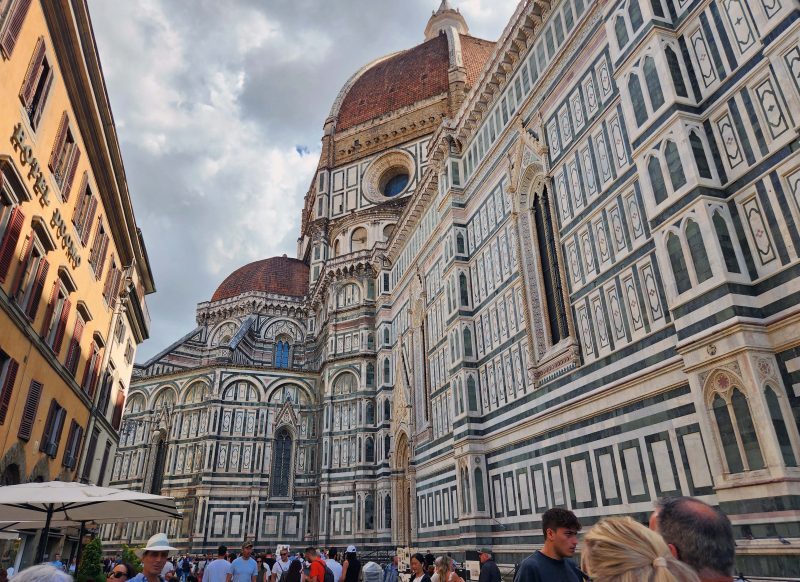
This is the front (west side) of the cathedral. The large alcove directly above the pointed decoration over the center door is the place where the David was supposed to be installed. The other statues across the front of the church at that level are important Italian historical figures, including Michelangelo. The church complex includes the cathedral, the bell tower (on the right in the photo), and the baptistery, which faces the front of the church. I didn’t take a picture of the baptistery, but it’s a very large, hexagonal building decorated like the cathedral.
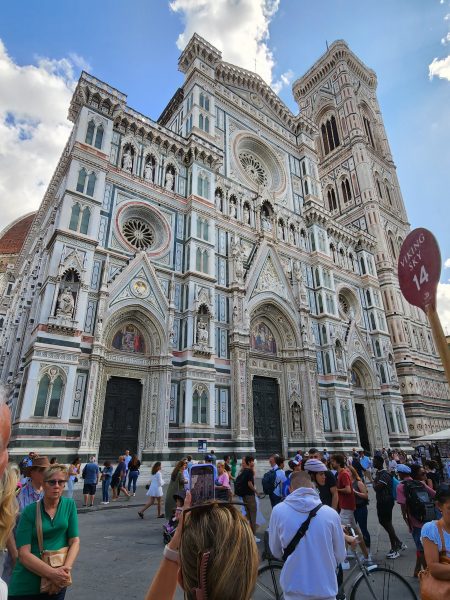
The free-standing bell tower—the Campanile di Giotto (Giotto was the architect)–is at the corner of the front of the church and the south side of the building. If you climb the 414 steps to its top, you’ll see Florence from its highest viewing platform. The view is described as “worth its weight in gold,” although I’m not sure how a view can have weight. You get the idea.
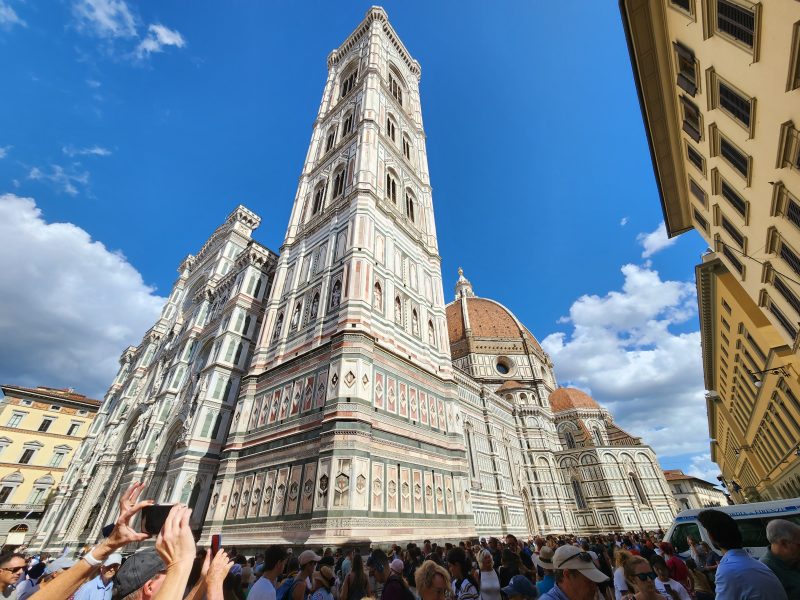
The entire cathedral is faced with three colors of marble—white, pink, and green. The colors are not representative of the Italian flag. The cathedral was completed in 1296; Italy’s current flag was adopted in 1946.
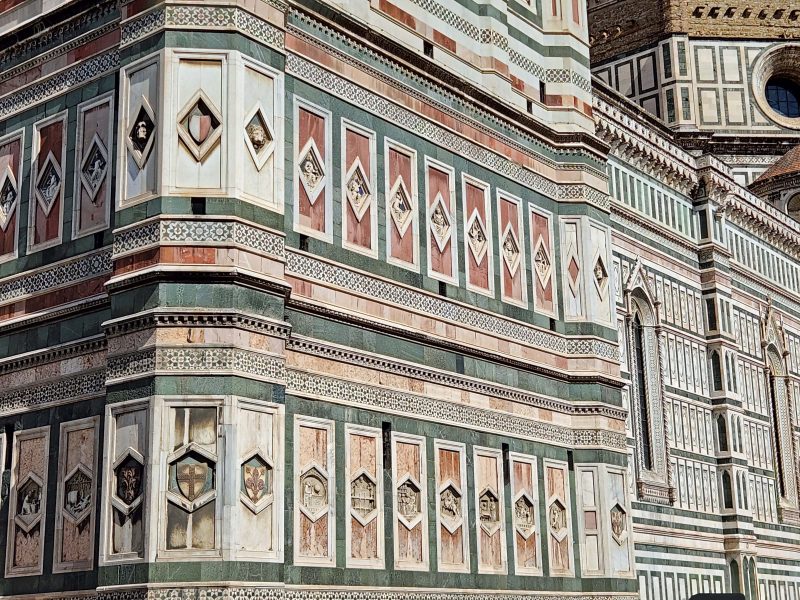
At this point, our guide left us to explore this historic area on our own. We saw this fountain with Neptune in the center. The sculptor fashioned Neptune’s features after Cosimo I in honor of Cosimo’s victory over Pisa, giving Florence access to the Mediterranean for trade.
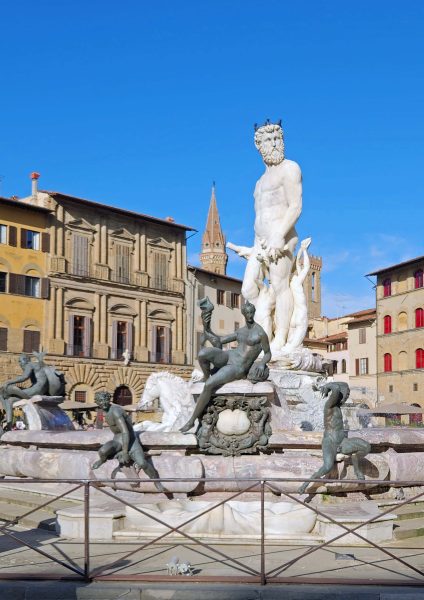
The Chiasso d’Baroncelli is a back street that connects two buildings that are part of a quadrangle. It’s near the Uffizi Gallery.
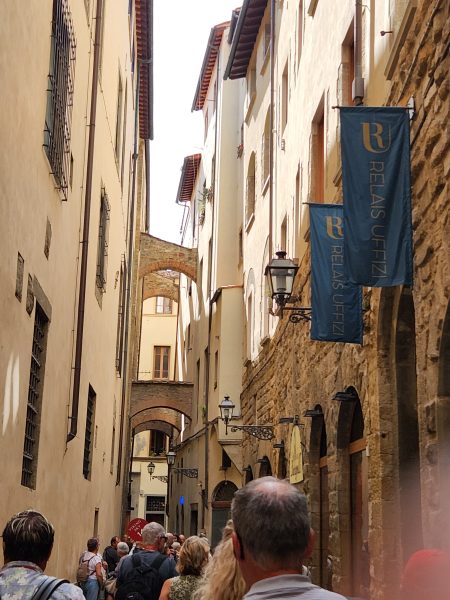
The Arcone Triumphal Arch is in the ancient heart of Florence, where artists and intellectuals gathered in the early 1900s. It was originally the site of Florence’s forum.
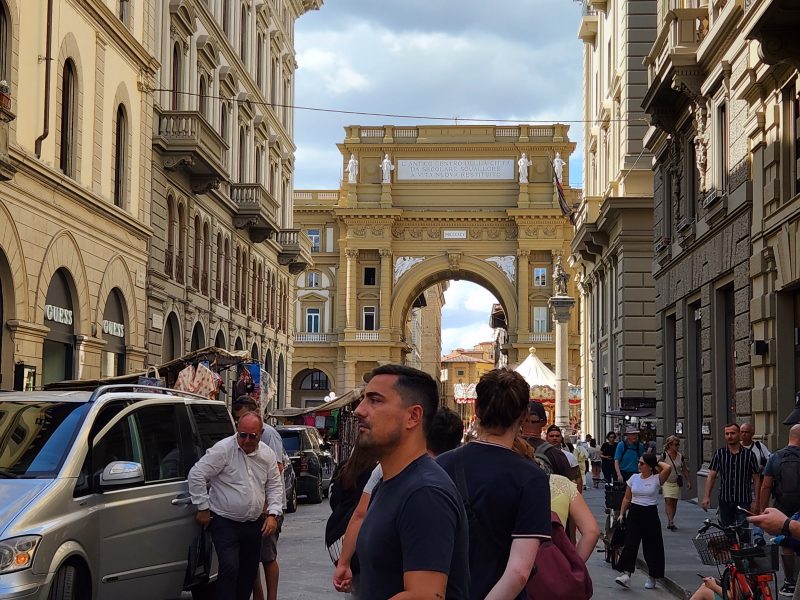
As we walked around the many piazzas in the area, we saw and heard two opera singers. This is one of them. I’m sure we’ve all seen guitar players, as well as other musicians and singers with some item on the ground to collect contributions in tourist-crowded areas, but I’ve never heard an opera singer outside of Italy—and we heard two within a few blocks of each other!
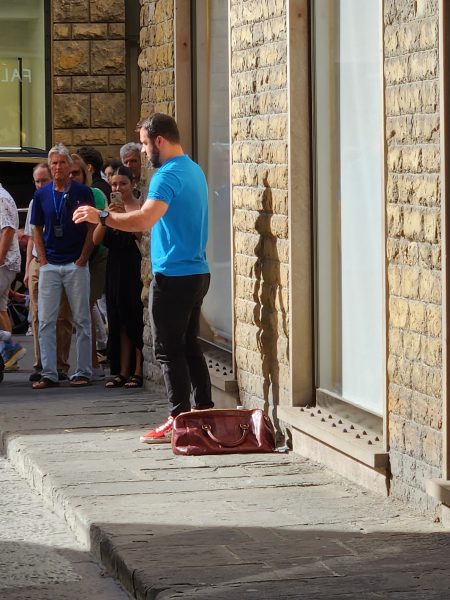
This figure on the Uffize Gallery is called “I passi d’oro”—”The Golden Strides.” In May 1993, Florence was struck by a Sicilian mafia (Cosa Nostra) attack that severely damaged several buildings including the Uffizi Gallery, killed five people, and injured 48 others. The attack was retribution for the trial and life imprisonment of a mafia boss. Similar attacks occurred in Milan and in Rome. On the 20th anniversary of the attack, the Uffizi Gallery commissioned this sculpture to portray hope and life after the tragic event. The six-foot statue of bronze, covered in gold leaf, depicts a striding figure on a blade of stone. The large figure is carrying five small figures (you can’t see all five from my angle) representing each of the five victims of the attack.
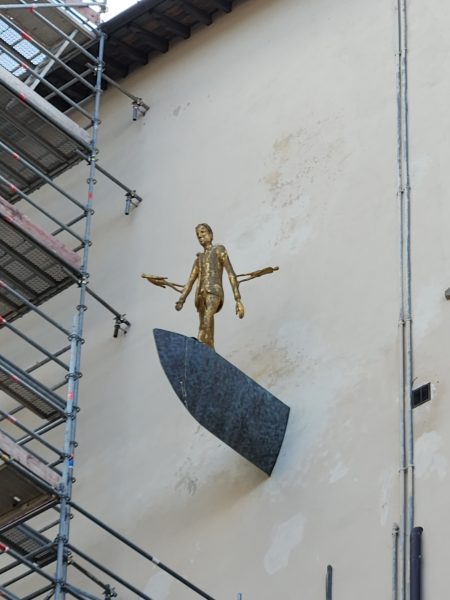
The “Albero della Pace,” or “Tree of Peace,” also commemorates the 1993 Mafia attack. It represents an olive tree with its roots clearly visible—a symbol of the close connection between the past and the present. It replaces a 100-year-old olive tree that was originally placed at this site but did not grow well. Like “The Golden Strides” and the original olive tree, its purpose is to pursue the ideals of love and hope.
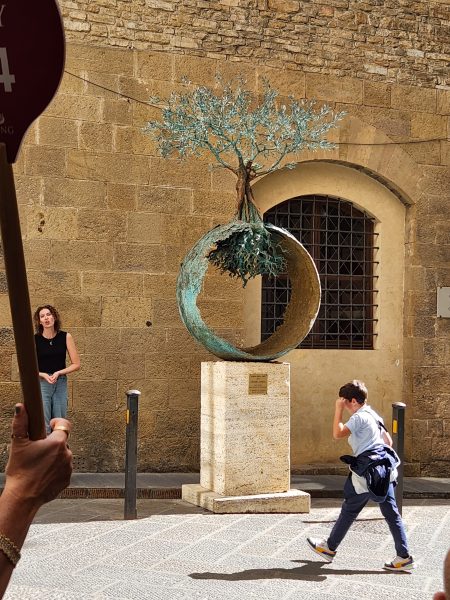
Before heading back to our group meeting place, Ted and I spent some time walking along the Arno River.
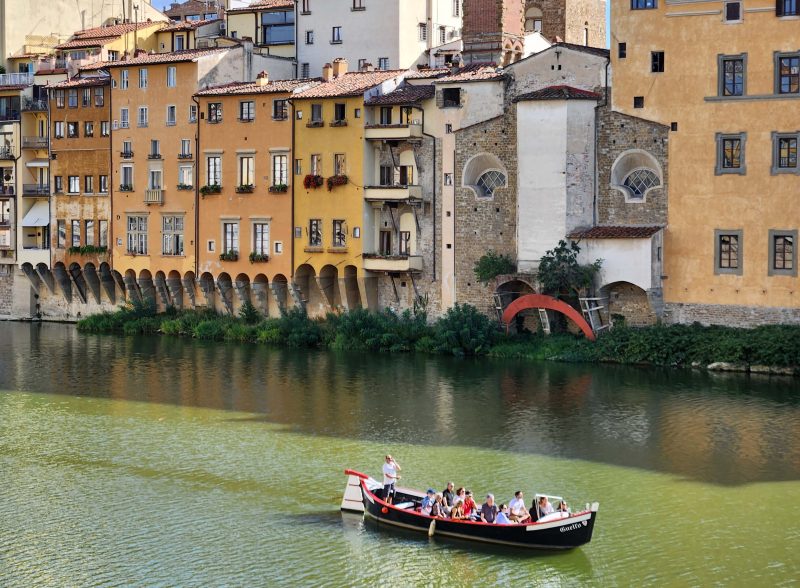
Tuscany is famous for its dramatic light, and there are actually destination sites for viewing the Tuscan sunsets. The sun set as we drove from Florence back to our ship in Livorno, and I’m sure our bus was not a prime sunset viewing spot. Still, even through the bus window, the sunset was the most magical one I’ve ever seen—everything turned gold, including the air and the light. I had to take this picture from the moving bus, but I wanted to remember that Tuscan gold sunset. The Tuscan sun is a real thing, not just a movie title.
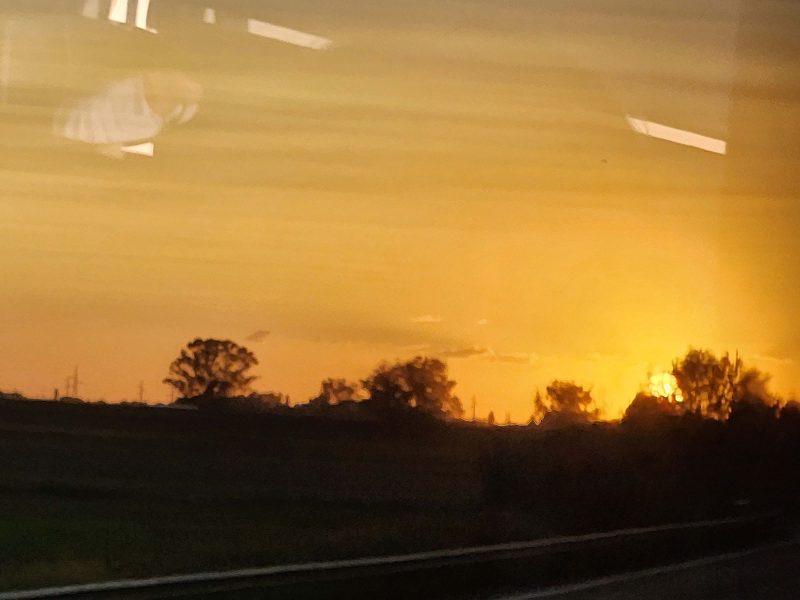
In addition to its sunsets, Tuscany is famous for the Vespa scooter—a simple, practical vehicle that can be seen all over Italy. It became the first globally successful scooter after Gregory Peck and Audrey Hepburn rode a Vespa around Rome in the movie Roman Holiday.
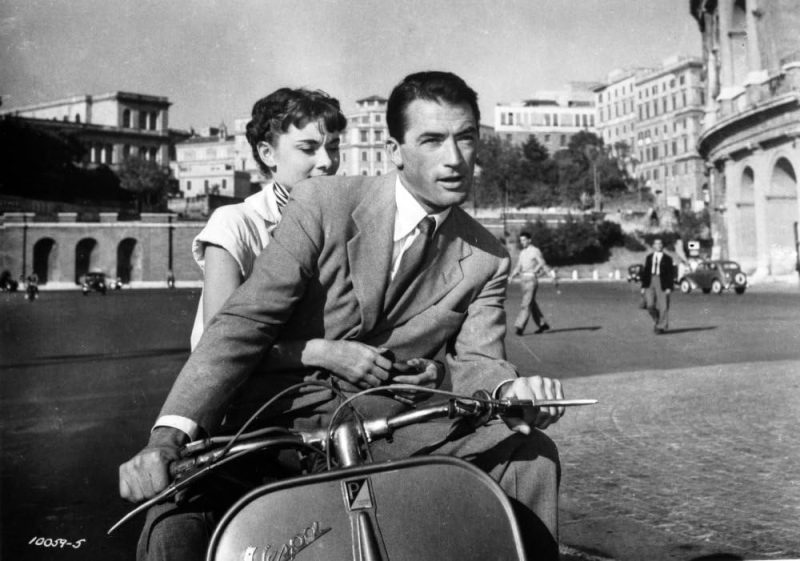
A bit of Italian trivia
How do you get out of a parking space in Florence? First drive forward and bump the car ahead of you; then bump the car behind you; and then pull out into the street. Ted and I actually saw cars parallel parked within two inches of the adjacent cars, so this advice might be true.
The Italian alphabet has no j or k, so our guide’s name was Giullia, not Julia. Ch changes the c sound to a k as in chianti and Pinocchio.
Guillia taught us Italian hand gestures for ordering beverages:
- Water—shape your hand as if you are holding a glass and bringing it to your mouth.
- Wine or alcohol—curl your three middle fingers under and extend your thumb and little finger, then bring your thumb to your mouth.
- Coffee—bring your first three fingers to your thumb and extend your little finger, then bring your hand to your mouth and twist it, bringing your little finger upward as if you are drinking from a cup.